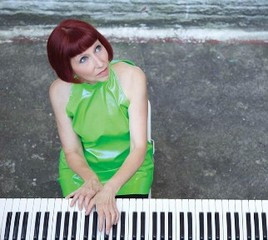|
Back
The Well-Tempered Shakuhachi New York
Tenri Cultural Institute
05/04/2014 -
“Exploding Bamboo”
Mohammed Fairouz: From Piano Miniatures: N° 7, N° 5, “Bargemusic”, “Lullaby for a Chelsea Boy”, “Liberace” & “For Syria”
James Nyoraku Schlefer: Brooklyn Reibo
Caroline Shaw: The Walking Man (World Premiere)
Randall Woolf: Hollow (World Premiere)
Mari Kimura: Four Cups of Tea (World Premiere)
Adrian Hon Chung Lam: Separated...at the Human Labyrinth of Asakusa Temple
James Nyoraku Schlefer (Shakuhachi), Kathleen Supové (Piano), Jennifer Choi (Violin), Wendy Law (Cello)

J. N. Schlefer (© An Xiao)
The previous times I’ve heard the apparently astonishing shakuhachi player, James Nyoraku Schlefer, he stuck me as a singular musician who made his singular Japanese instrument into a thing of utmost beauty. But those times, he had been playing his various-sized bamboo flutes in ensemble with other instruments, both Japanese and European.
Yesterday afternoon at the Tenri Cultural Institute, he did have some wonderful ensemble pieces. But performing two long pieces solo, Mr. Schlefer did not appeal so much to my restricted emotions. Confessedly, my own long Asian sojourns encompassed the gamelan family, in Cambodia, Malaysia and Thailand. On visits to Japan, I couldn’t grasp the music. It was far too mysterious. The music I heard would not put me “in the mood” (whatever that is), but I would have to be in the mood before listening.
Although I tried prepare myself for this concert (bottles of saké and snacks the previous night, reading a French philosopher, who had a Zen attitude when tortured by the Khmer Rouge), Mr. Schlefer’s two long solo pieces left me personally cold. I was awed at what he could do with the instrument. But otherwise the reaction was partly utmost respect–and partly I feared he might make a sound like chalk on a blackboard.
Which, of course, he didn’t. For a religious work, he slowly went around the small stage, and didn’t stop for the second work, simply switching flutes. His mastery of overtones, breath control, the subtlest trills, the most nuanced tones, was all wonderful. Yet, like a diner examining the rarest ingredient, I was anxious to see how the master chefs could use that exotic ingredient in their own concoctions.
The compositions varied, but the musicians were indeed masters, their mastery heard by the populace with orchestras, but for stalwarts of smaller concert halls (or in this case an art gallery), they take the most complex contemporary music firmly in their stride.

K. Supové (© Courtesy of the Artist)
Kathleen Supové’s "exploding piano” generates a personality that usually transcends her instrument. And her opening solo of Mohammed Fairouz’s conservative bagatelles were evocative (everything from Liberace flamboyance to a morbid lullaby for the dead children of Syria). Jennifer Choi has played with the great youthful string quartets of today, and Wendy Law’s cello can be heard in the most diverse settings in New York and internationally.
Their works with Mr. Schlefer’s shakuhachi varied, but I fell in love with the duo Four Cups of Green Tea by Mari Kimura (Kyo-Shin-An Arts Commission). The explanation was anecdotal, complex and fascinating. With a play on words, the “four cups” were the four ships of Admiral Perry, and the music, amongst other things, was an interplay of Japanese and Western music.
That by itself didn’t sound promising, but Ms Kimura shattered all expectations. Beginning with piano and flute in unison with a pentatonic song, it branched out with varieties of music, including quotes from Debussy’s Faun, Varèse’s Density 21.5 and a sailor’s song of the period. Yet the quotes were in the background, they harmonized without cadences. Instead of Debussy’s flute solo, we heard the harmonies. Scott Joplin’s Maple Leaf Rag eschewed the tune for the scales around it. Ms. Supové played sometimes like a piano, sometimes like a Japanese cembalon, even using the inner strings of the piano. Like a great mural of Japanese history–but no particular events–Messrs Schlefer and Supové wrote the history their own way, faultlessly weaving Japanese and Western modes around each other.
Randall Woolf’s Hollow (another Kyo-Shin-An Arts Commission) was written for the full quartet (Mr. Schlefer confessed that not too much shakuhachi piano trios exist), and Mr. Woolf will obviously fix that situation. He admitted that he hadn’t known much about Japanese music, but that didn’t stop him from a multi-movement work with one basic motive: a minor third, which went through a variety of incarnations, with a faintly jazzy set of modulations.
Finally came Adrian Hon Chuang Lam’s Separated...at the Human Labyrinth of Asakusa Temple, which was nowhere near its lumbering title. In fact, it was a delightful piece, partly played in ensemble, partly with solos and duets. We started with a piece of aural legerdemain as Mr. Schlefer blew into the piano, using the piano box to echo the notes. As the piece progressed, everybody got a share of the Orient/Occident melodies and silences.
The ending was terrific. Mr. Schlefer played a cadenza which was short, pointed and gave him all the soloistic chops that he needed. After that came a surprise. This was mainly a good Western-styled (sometimes almost lushly romantic) piece. But at the end, Ms Choi’s violin and Ms. Law’s cello ended with those “bent” notes which are so common with the shakuhachi.
It was as if the composer wanted to show opposing hemispheres in one distorted chord. And a fitting climax. For we inevitably see different worlds through a glass which is distorted, opaque, cracked. This afternoon, our aural vision packed, if not concord, a rare musical confluence.
Harry Rolnick
|